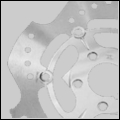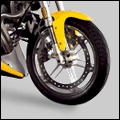Brake Discs
Brake discs are used on the front and rear of most modern motorcycles but some older bikes or those with a lesser performance in terms of top speed have been deemed suitable for only using a drum brake on the rear.
Brake discs have a rotor (the disc) which is clamped on by a friction material called the brake pads. The main advantages of using brake discs instead of drum brakes are:
- More resistant to brake fade
- Better cooling efficiency
- Water and dirt resistant
- Less maintenance
- Greater surface area for a given weight of brake
This greater resistance to fade is the most important advantage over drum brakes and is due to the friction surfaces are directly exposed to cooling air and because drum deflection is eliminated from the system.
The hottest part of the braking system is where the friction material contacts either the drum or disc. For a drum brake to cool down the entire drum has to increase in temperature then the drum is cooled by the air around it. The disc however is cooled immediately by air blowing on the discs rubbing surface.
This makes the contact surfaces 'potentially' more liable to damage from corrosion from dirt or water contamination but it reality the constant wiping action of the pads on the discs keeps the surface clean. Centrifugal force also throws material off the brake disc as the disc rotates.
Disc brake pads are easier to change than drums and they are also easier to adjust. Disc brakes are designed to run with little clearance and are self adjusting when they are applied. Disc brake swept area (the area swept by the pads when brakes are applied) is larger than the swept surface area of the drum as the drum only has one side (inside) swept.
Swept area of a brake is an important measure of it's effectiveness. The swept area of the disc is the total area contacted by all the brake pads in one revolution of the disc. This combined swept area of all brakes can be divided by the weight of the bike to give an indication of how effective the brakes are likely to be.
Some discs have slots or holes machined in them to reduce the hot-gas and dust particle build up between pad and disc. This reduction reduces pad glazing and when considered in terms of racing when pads are larger and temperatures are high hot gases have a harder time trying to escape than with small pads.

Discs are also available with a 'wavey' designed outer ring which offer strong initial grip, perfect pad cleaning, greater perimetal surface with greater heat dissipation, possible expansion towards the middle circumference avoiding conic deformations and less weight

Recently a new design of rim mounted brake discs have also been available to the public and can be seen on oem motorcycles such as the new Buells. These discs offer some more excellent characteristics such as a much larger surface area offering greater cooling efficiency, larger swept area offering a much more long wearing and powerful brake, a zero torsional load and significantly reduces unsprung weight.
